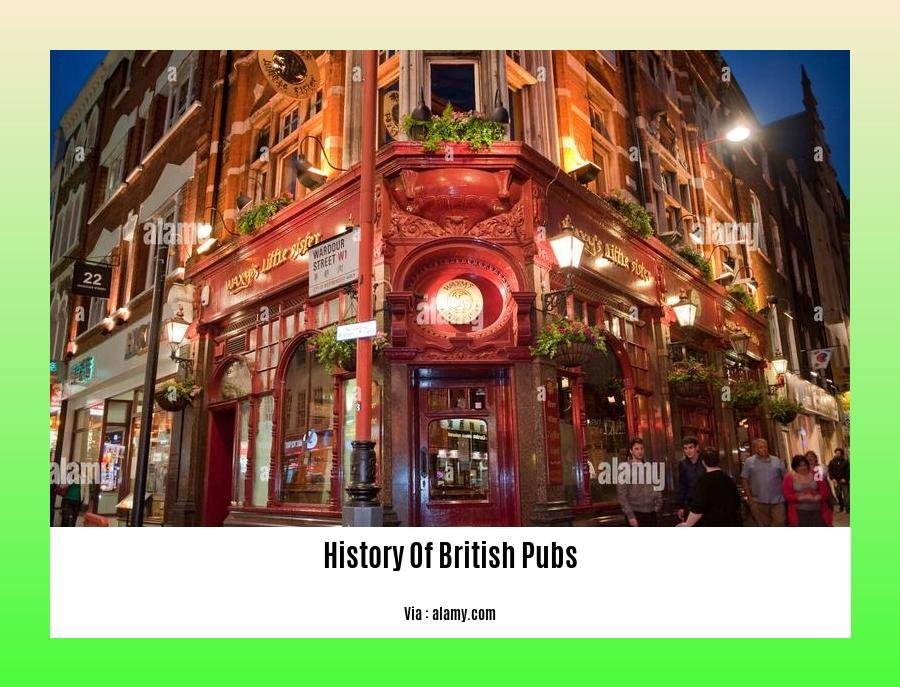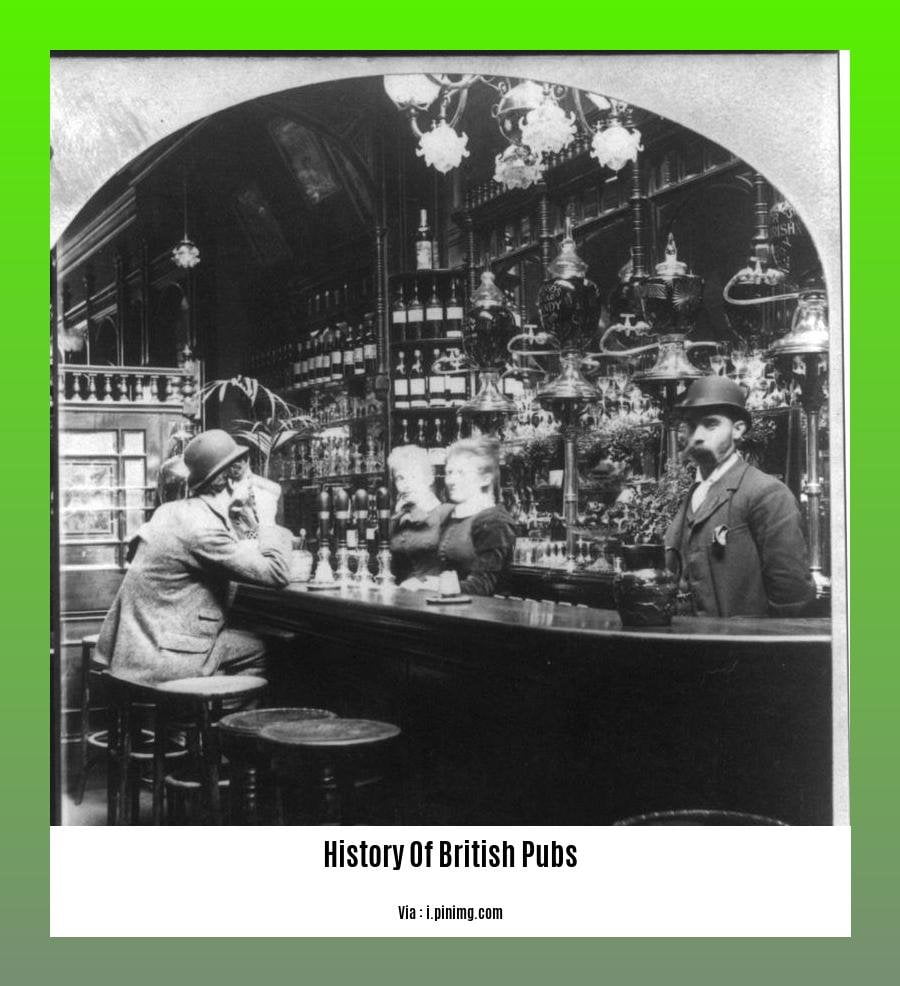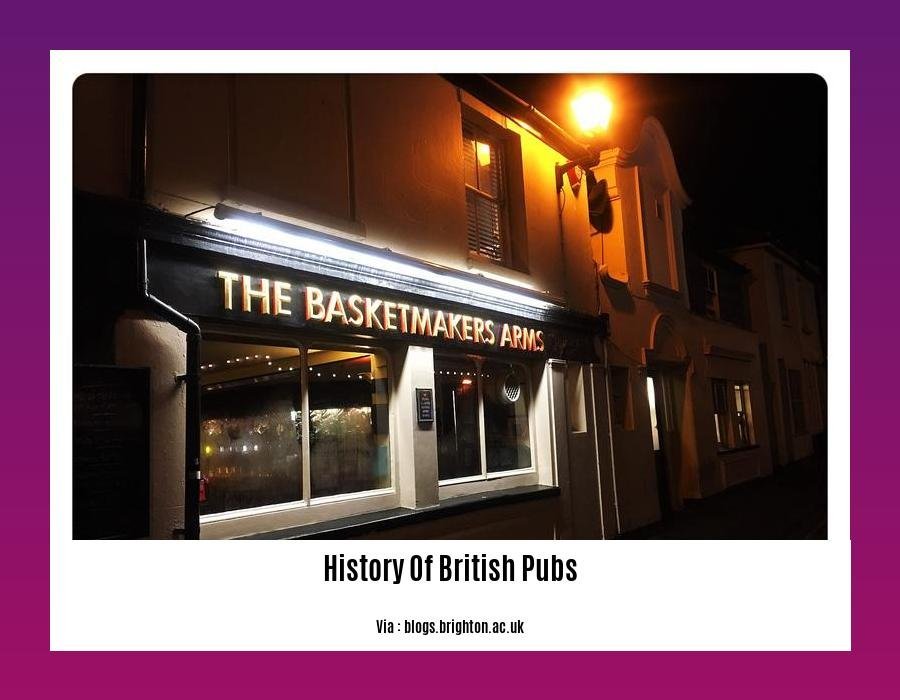Embark on a captivating journey through time as we unveil the rich history of British pubs, deeply ingrained in the cultural fabric of the nation. From their humble origins as medieval ale houses to their transformation into vibrant social hubs, these iconic establishments have borne witness to centuries of laughter, camaraderie, and storytelling. Join us as we delve into the captivating tales that these beloved institutions hold, revealing the profound impact they have had on British society, culture, and economy.
Key Takeaways:
- Romans introduced “Tabernae,” the earliest recorded pubs, to Britain in 43 AD.
- Anglo Saxons established alehouses around 400 AD.
- During the Medieval Period, inns and taverns offering lodging and food became popular.
- The 19th Century witnessed the rise of beerhouses and gin palaces due to the growing popularity of beer and gin.
- In the 20th Century, pubs underwent modernization, improving their infrastructure, facilities, and services.
- In the 1970s, pubs faced challenges due to economic recession and changing societal norms.
- A revival of interest in traditional pubs and cask ales occurred in the 1980s.
- Throughout the 1990s, pubs continued to evolve, adapting to customer preferences with the rise of themed pubs and gastropubs.
History of British Pubs

Let’s journey into the past, shall we? The history of British pubs is an epic tale that goes back to the Romans in 43 AD. They brought their own pubs, known as Tabernae, and introduced the locals to the joys of drinking in a social setting.
Fast forward to the 400s, and the Anglo Saxons were brewing up their own version of pubs called alehouses. They were quite popular and became a staple of village life.
During the medieval period, inns and taverns gained prominence. These were more than just drinking establishments; they offered much-needed food and lodging to travelers.
In the 19th century, two new types of drinking establishments emerged – beerhouses and gin palaces. Beerhouses catered to the working class, offering affordable beer, while gin palaces were more upscale, catering to the upper classes with a wide selection of gins.
The 20th century brought about modernization for pubs. they were equipped with better infrastructure, facilities, and services. During that time, pubs were an integral part of British culture.
However, the 1970s posed challenges for pubs. Economic recession and changing social norms led to a decline in their popularity.
But hey, the 1980s saw a revival! Traditional pubs and cask ales became trendy again, and pubs made a comeback.
The 1990s marked another adaptation period for pubs. They evolved to cater to diverse customer preferences, with themed pubs and gastropubs gaining popularity.
Today, pubs remain an integral part of British life and culture. They’re not just places to drink but also community hubs where people gather to socialize, celebrate, and create memories.
So, let’s raise a glass to the history of British pubs. May they continue to be places where stories are told, friendships are forged, and good times are had!
-
Be baffled no more! Discover the fascinating story of Brazilian Jiu Jitsu’s origins and evolution. history of brazilian jiu jitsu
-
Delve into the chronological journey of building materials, from ancient civilizations to modern marvels. history of building materials timeline
-
Tee off with knowledge! Explore the rich history of Callaway drivers and witness how they revolutionized the world of golf. history of callaway drivers
Architecture, Design, and Atmosphere of Traditional British Pubs
Fancy a pint in a place that transports you back in time? Traditional British pubs, with their timeworn facades and warm, inviting interiors, offer a compelling journey through architectural styles and design trends that have shaped these iconic social hubs across Britain.
Traditional Styles Embraced:
Traditional British pubs have primarily adopted three prevalent architectural styles:
- Tudor Style:
- Half-timbered exteriors with exposed wooden beams lend a rustic charm.
- Georgian Style:
- Symmetrical facades with sash windows and decorative woodwork evoke elegance.
- Victorian Style:
- Elaborate facades with ornate details, bay windows, and colorful tiles showcase Victorian exuberance.
Design Elements Shaping Pubs:
Beyond architectural styles, pubs have distinctive design features that enhance their welcoming atmosphere:
- Snug Corners and Low Beams:
- Cozy nooks and low ceilings create intimate spaces for conversations.
- Fireplaces and Hearths:
- Warm, inviting fireplaces offer comfort and a sense of history.
- Stained Glass Windows and Mosaics:
- Intricate stained glass windows and mosaic tiles add character and color.
- Brass Taps and Wooden Bars:
- Polished brass taps and sturdy wooden bars add a touch of sophistication.
Atmosphere: The Heart of a Pub
The convivial atmosphere of traditional British pubs is palpable. Step inside, and you’re enveloped in a tapestry of sounds, aromas, and warmth:
- The Buzz of Conversations:
- Lively conversations fill the air, creating a sense of camaraderie.
- The Scent of Hops and Barley:
- The malty aroma of beer blends with the scent of hops, evoking a sense of relaxation.
- Landlords and Landladies:
- Friendly publicans, or landlords and landladies, welcome guests with open arms, ensuring everyone feels at home.
Key Takeaways:
- Traditional British pubs embrace various architectural styles, including Tudor, Georgian, and Victorian.
- Design elements like snug corners, low beams, fireplaces, stained glass windows, and brass taps contribute to their charm.
- The atmosphere in traditional pubs is warm and inviting, characterized by lively conversations, the scent of beer, and friendly publicans.
Sources:
- The Changing Face of the Pub: 1960–2020 – SAHGB
- A deep dive into British pub culture – Reader’s Digest
Famous Pubs and Their Legends: Historical Anecdotes

Embark on a captivating journey as we delve into the hallowed halls of Britain’s most renowned pubs, where history unfolds like a well-aged ale. Within these time-worn walls, tales of legendary encounters, intriguing characters, and pivotal events intertwine, creating a rich tapestry of heritage that echoes through the centuries.
The Ye Olde Cheshire Cheese
Nestled in the heart of London’s historic Fleet Street, The Ye Olde Cheshire Cheese stands as a testament to the enduring spirit of British pubs. Its labyrinthine interior, a relic of centuries past, offers glimpses into its illustrious clientele, including literary giants like Charles Dickens and Mark Twain, who sought solace and inspiration within its cozy nooks. Legends say that the ghost of a former landlord, known as “Mr. Cheese,” still roams the pub’s creaky corridors, keeping a watchful eye over its timeless legacy.
The Lamb and Flag
In the vibrant city of Oxford, The Lamb and Flag is more than just a pub; it’s an institution. Steeped in political intrigue, it’s where the gunpowder plotters hatched their ill-fated scheme to blow up the Houses of Parliament. Its secret tunnels and hidden chambers whispered tales of rebellion and resistance, echoing the clandestine meetings that took place within its walls. As you sip your pint, imagine the whispers of history conspiring in the shadows, leaving an indelible mark on this hallowed ground.
The Admiral Benbow
Venture to the coastal town of Portsmouth and discover The Admiral Benbow, a pub that embodies the spirit of maritime adventure. Named after the legendary naval hero, Admiral Benbow, its walls are adorned with relics from the golden age of sailing. Sailors and explorers from distant lands once gathered here to spin yarns of their daring exploits and toast to their safe return. The pub’s nautical atmosphere transports you to an era of swashbuckling pirates and tales of the seven seas, evoking a sense of wonder and adventure.
The Prostitute’s Arms
In the heart of Bristol, The Prostitute’s Arms carries a name steeped in intrigue and controversy. Legends whisper that in the 18th century, a group of women who worked in the city’s notorious St. Nicholas Market sought refuge within these walls, turning it into a place of respite and camaraderie. Its colorful history is woven into the very fabric of the pub, where patrons can raise a glass to the resilience and spirit of those who frequented this unique establishment.
Key Takeaways:
- British pubs are steeped in a rich history, serving as meeting places for legendary figures from all walks of life.
- Each pub holds its own unique tales of intrigue, from literary giants finding inspiration to political plots unfolding in secret chambers.
- The atmosphere in these pubs transports visitors back in time, allowing them to connect with the past and experience the essence of Britain’s vibrant pub culture.
- Patrons can raise a glass to the resilience and spirit of those who frequented these iconic establishments, honoring their legacy and preserving their stories for generations to come.
- The Ye Olde Cheshire Cheese, The Lamb and Flag, The Admiral Benbow, and The Prostitute’s Arms are just a few examples of the many renowned pubs that dot the British landscape, each with its own unique character and historical anecdotes to share.
Sources:
- The Changing Face of the Pub: 1960–2020 – SAHGB.
- A deep dive into British pub culture – Reader’s Digest.
The Future of Pubs: Challenges and Opportunities
British pubs, the heart and soul of local communities, have long been facing an uncertain future. The traditional business model, rising costs, changing consumer preferences, and the impact of the pandemic have all contributed to a decline in pub numbers. But amidst these challenges, there are opportunities for pubs to adapt and thrive in the modern landscape.
Challenges Faced by Pubs
-
Changing Consumer Preferences: Pubs are competing with a wide range of entertainment options, from home streaming services to late-night bars and restaurants.
-
Rising Costs: The cost of rent, utilities, and staff wages has been steadily increasing, putting pressure on pub profits.
-
Impact of the Pandemic: The COVID-19 pandemic forced many pubs to close for extended periods, leading to lost revenue and a decline in footfall.
Opportunities for Pubs
-
Diversification: Pubs can explore new revenue streams by offering food, hosting events, or providing entertainment to attract customers.
-
Community Engagement: Pubs can strengthen their ties with the local community by hosting events, supporting local charities, and offering a welcoming space for people to socialize.
-
Digital Transformation: Pubs can leverage technology to improve their efficiency and reach a wider audience through online reservations, loyalty programs, and social media marketing.
-
Government Support: The UK government has introduced several initiatives to support the pub sector, including tax breaks and grants.
-
Adapting to Changing Needs: Pubs can adapt their offerings to meet the changing needs of consumers, such as providing more outdoor seating, offering healthier food options, and hosting family-friendly events.
Key Takeaways:
- Britain’s pubs are facing challenges due to changing consumer preferences, rising costs, and the impact of the pandemic.
- Pubs can adapt and thrive by diversifying their offerings, engaging with the community, embracing digital transformation, and taking advantage of government support.
- The future of pubs lies in their ability to embrace innovation and adapt to the evolving needs of consumers.
Sources:
The Future of Pubs: Challenges and Opportunities
The Changing Face of the Pub
FAQ
Q1: What was the earliest form of a pub in Britain?
A1: The earliest form of a pub in Britain was the Tabernae, introduced by the Romans in 43 AD. These establishments primarily served wine to Roman legionaries.
Q2: How did pubs evolve during the medieval period?
A2: During the medieval period, inns and taverns emerged, offering lodging, food, and drinks to travelers and locals. These establishments became popular stopovers along trade routes and pilgrimage paths.
Q3: What factors contributed to the rise of beerhouses and gin palaces in the 19th century?
A3: The growing popularity of beer and gin during the 19th century led to the establishment of beerhouses and gin palaces. These specialized establishments catered to the working class, offering affordable alcoholic beverages and often featuring elaborate decor.
Q4: How did pubs adapt to changing social norms and economic challenges in the 20th century?
A4: In the 20th century, pubs underwent modernization to meet the demands of a changing society. Improvements in infrastructure, facilities, and services were made, and pubs began to offer a wider range of food and entertainment options to attract customers.
Q5: What are some of the challenges faced by pubs in recent decades?
A5: In recent decades, pubs have faced a number of challenges, including economic recession, changing consumer preferences, the rise of home entertainment, and the impact of the COVID-19 pandemic. Pub closures and conversions to alternative uses have become increasingly common.
- Unveiling the Enigma: Mansoureh Khojasteh Bagherzadeh’s Public Appearances & Private Life in Iran - July 18, 2025
- Unveiling the Mystery: Mansoureh Khojasteh Bagherzadeh’s Husband: A Rare Glimpse into a Private Life - July 18, 2025
- Unveiling Masoud Khamenei’s Mother: Power, Influence, and Iran’s Future - July 18, 2025
















